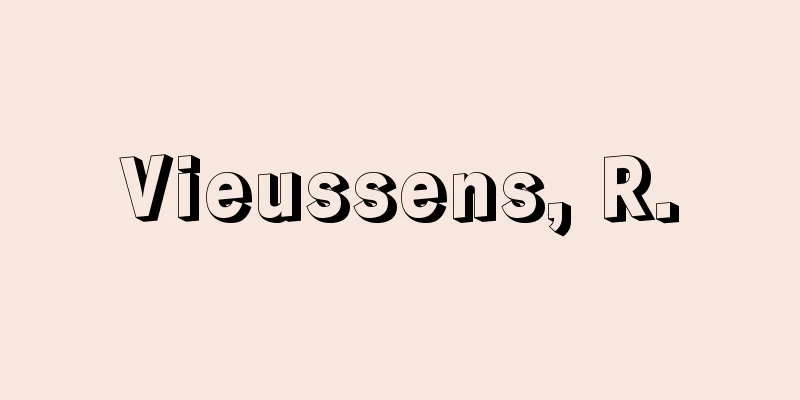Body color - coloration

|
This refers to the color exhibited by the body surface of an animal. There are two types of body color: chemical color, which is the result of selective absorption of visible light by pigment molecules, and structural color, which is the result of tissue structures that are colorless in themselves, such as microscopic folds, stripes, surfaces, and layers, that break down light into its component spectra through reflection, interference, and scattering. [Shoji Baba] Chemical and structural colorChemical colors include a wide variety of colors due to respiratory pigments such as hemoglobin, metabolic products such as melanin and purines, and carotenoid pigments. Many of these pigments have been isolated and purified from living organisms, and their chemical properties have been elucidated. Pigments are often contained in pigment cells, and are usually in the form of granules. On the other hand, structural colors due to reflection include air bubbles in the feathers, fur, and hair of birds, and white colors due to total diffuse reflection by calcium carbonate colloids in mollusks and corals. Coloring due to interference is seen in the scales of butterfly wings, the elytra of beetles, the body surface of reptiles, and the nacreous layer of shells. The blue skin seen on the head and neck of turkeys and cassowaries is due to blue to purple light being scattered by a colloid layer and other light being absorbed by the melanin in the lower layer. Chemical colors are expressed regardless of optically effective fine structures, but structural colors are greatly reinforced and emphasized by the presence of pigments. [Shoji Baba] Body color changeSome animals can change body color, but this is due to changes in the amount of pigment, or the movement, contraction, or expansion of pigment granules in chromatophores, which are large, branching cells among pigment cells. Contraction means that the pigment granules gather in the center of the chromatophore, resulting in a lighter overall color. Expansion means that the granules spread into the cell's protrusions, making the overall color appear darker. In cephalopods, the chromatophore is suspended by muscle fibers arranged radially in the chromatophore cavity, and the contraction and relaxation of these muscles causes the chromatophore to expand and contract. This allows octopuses and squids to change body color quickly. It is thought that the cobalt sparrow can change its structural color due to interference by changing the spacing of the multilayered thin films. These body color changes are caused by stimuli such as light and temperature, and are controlled by endocrine and nervous systems. This mechanism is well developed in fish, amphibians, reptiles, crustaceans, and insects. [Shoji Baba] Function of body colorSome animal body colors are thought to be beneficial to the survival of the animal. These are probably adaptive as a result of natural selection, and are therefore broadly called adaptive colors. Adaptive colors include cryptic colors, which act to hide the presence of an animal in the environment, and marker colors, which act to make the animal conspicuous. In both cases, they serve to protect the individual or species of the animal, and are therefore sometimes called protective colors. The former in particular is often called protective coloration. Some camouflage colors are relatively simple, such as the white body color of animals that live on snow and ice, such as the Arctic fox, and the green body color of many insects that live on plant leaves. However, some, such as the nightjar and the rock grasshopper, resemble not only the color but also the pattern and texture of tree bark or sand. Some, such as leaf beetles, stick insects, grasshoppers, and some praying mantises, deceive predators and prey by mimicking not only the color but also the form, posture, and movement of leaves, twigs, and flowers. This type of complex camouflage is sometimes called mimicry. Many tropical fish and tropical frogs have spots of a color that is rather conspicuous, which makes the outline of their body unclear and reduces the three-dimensional effect, which may actually have a camouflage effect. This is called segmented coloration. Some species, such as the common holly, eliminate shadows and enhance their camouflage effect by using reverse lighting from their light-emitting organs, or by using reverse shading caused by a dorsal side that is darker than the ventral side, such as surface saltwater fish and sand-dwelling lizards. In either case, the camouflage effect is high when the body color matches the background. In some cases, animals choose a background that matches their body color, but in other cases, such as fish such as flounder and sea urchins, and many crustaceans, they change their body color to match the color of the background. In the latter case, the effect that the color of the background has on the body color is called the background effect. Signaling color is an attempt to increase fitness by advertising its presence, and is also called advertising color. When animals with poisonous stingers, unpleasant secretions, or venom, such as wasps, ladybugs, and poison dart frogs, use this to warn predators of their presence and help them learn about it, thereby protecting the species, it is called warning coloration or alert coloration. When an animal that does not have a characteristic that is unpleasant to predators is protected by having the same warning coloration as an animal that is disliked by predators, it is called Batesian mimicry. An example of this is the mimicry of horseflies and flies imitating wasps. When several species that are disliked to various degrees share a common warning coloration and thus increase their protective effect, it is called Mullerian mimicry. When a color helps to avoid predation by scaring predators, such as the eye pattern seen on the hind wings of peacock butterflies, it is called a threat coloration. Signaling coloration that serves as a releaser for social behaviors such as mating behavior, sexual behavior, fighting, and child rearing among individuals of the same species is called recognition coloration. In the swallowtail butterfly, the female's wings have a black background with yellow stripes, which is the recognition color for mating behavior. [Shoji Baba] "Body Colors of Animals" by Toshitaka Hidaka (1983, University of Tokyo Press)" ▽ "Mimicry: Nature Lies, too" by W. Wickler, translated by Setsuko Haneda (1983, Heibonsha)" ▽ "Stories of Bioluminescent Creatures: Animal Stories to Read" by Yata Haneda (1980, Hokuryukan) Source: Shogakukan Encyclopedia Nipponica About Encyclopedia Nipponica Information | Legend |
|
動物の体表面が呈する色彩をいう。体色には、生体色素分子による可視光の選択的吸収の結果として着色する化学色と、それ自体では無色の組織構造、たとえば顕微鏡的大きさのひだ、縞(しま)、面、層などが、反射、干渉、散乱によって光線をその構成スペクトルに分解することにより着色する構造色とがある。 [馬場昭次] 化学色と構造色化学色には、ヘモグロビンなどの呼吸色素、メラニンやプリン類のような代謝産物、カロチノイド系色素などによる多種多様の色彩がある。これらの色素の多くは、生体から単離精製され化学的性質も明らかにされている。色素は多くの場合色素細胞に含まれていて、普通は顆粒(かりゅう)となっている。一方の構造色のうち、反射によるものとしては、鳥類の羽、毛皮、毛髪中の気泡、軟体動物やサンゴ類などの炭酸カルシウムのコロイドによる全乱反射による白色がある。干渉による着色は、チョウのはねの鱗片(りんぺん)、甲虫類の上翅(じょうし)、爬虫(はちゅう)類の体表や貝殻の真珠層などにみられる。シチメンチョウやヒクイドリの頭や頸(くび)にみられる青い皮膚は、コロイド層によって青ないし紫の光が散乱され、他の光が下層のメラニンによって吸収されたことによる。化学色は光学的に有効な微細構造と無関係に発現されるが、構造色は色素の存在によって大いに補強、強調される。 [馬場昭次] 体色変化体色が変化する動物もあるが、その原因は、色素の量が変化したり、色素細胞のうちでも大形で樹枝状の突起をもつ色素胞とよばれる細胞の中で、色素顆粒が移動、収縮、拡張することによる。収縮というのは色素顆粒が色素胞の中央に集まることで、その結果、全体として色は淡くなる。拡張のときは顆粒が細胞の突起の中にまで広がり、全体として濃くみえる。頭足類では色素胞腔(こう)に放射状に配置する筋繊維によって色素胞が懸垂されていて、この筋肉の収縮・弛緩(しかん)によって色素胞の拡張・収縮がおこる。これによってタコやイカは速やかな体色変化をすることができる。コバルトスズメでは、多層薄膜の間隔を変化させることにより干渉による構造色を変化させることができると考えられている。これらの体色変化は光、温度などの刺激により、内分泌的支配、神経支配を受けておこる。その仕組みは魚類、両生類、爬虫類、甲殻類、昆虫類でよく発達している。 [馬場昭次] 体色の機能動物の体色には、その動物の生存に利すると考えられるものがある。おそらくは自然淘汰(とうた)の結果としての適応的なものと考えられるので、広く適応色という。適応色には、動物の存在を環境の中に隠してしまうように働く隠蔽色(いんぺいしょく)と、その反対に動物の存在を目だたせるように作用する標識色とがある。どちらの場合にも、動物の個体あるいは種の保護の役割を果たすので、保護色ということがある。とくに前者の場合、保護色ということが多い。 隠蔽色には、ホッキョクギツネなどの雪や氷の上で生活する動物の白い体色や、植物の葉の上で生活する多くの昆虫の緑色の体色など比較的単純なものもあるが、ヨタカやカワラバッタのように、樹皮や砂地に色彩のみならず模様やきめまで類似しているものもある。コノハムシ、ナナフシ、ハゴロモ、ある種のカマキリのように、木の葉、小枝、花などに色彩ばかりか、形態や姿勢、動きなどの行動まで似せて、捕食者や獲物を欺く場合もある。このような複合的なカムフラージュを強調して擬態とよぶこともある。多くの熱帯魚、熱帯産のカエルなどで、それ自身はむしろ目だつ色彩の斑紋(はんもん)をもつために、体の輪郭がはっきりしなくなり、立体感も薄れ、かえって隠蔽効果が生ずる場合があり、分断色とよばれる。コバンヒイラギのように発光器による逆投光や、表層の海水魚や砂地にすむトカゲのように背側が腹側より色が濃いことによる反対陰影によって、影を消し隠蔽の効果を高めるものもある。いずれにしろ隠蔽の効果は、体色と背景があっている場合に高い。動物が体色にあった背景を選ぶ場合もあるが、ヒラメ、ドロメなどの魚や、多くの甲殻類のように、背景の色彩にあわせて体色を変化させる場合もある。後者の場合、背景の色彩が体色に及ぼす効果を背地効果という。 標識色は、自己の存在を広告することによって、適応度を高めようとするもので、広告色ともよばれる。スズメバチ、テントウムシ、ヤドクガエルのように、毒針、不快なにおいや味の分泌物、毒液をもつ動物が、捕食者に対してそのことを警告して学習させ、種の保護に役だてている場合、警告色または警戒色という。捕食者にとって嫌な性質を備えていないものが、捕食者に嫌われているものと同じ警告色をもっていることによって保護されている場合、ベイツ型擬態という。アブやハエがハチをまねた擬態がこれである。また、さまざまな程度に嫌われているいくつかの種が共通の警告色をもつことによって、保護効果を高めている場合、ミューラー型擬態という。クジャクチョウの後翅などにみられる目玉模様のように、捕食者を脅かすことによって捕食を免れるのに役だっているものを威嚇色という。同種個体間での配偶行動、性行動、闘争、育児などの社会行動のリリーサーとなっている標識色を認識色という。ナミアゲハでは、雌のはねの黒地に黄色の縞模様が配偶行動の認識色である。 [馬場昭次] 『日高敏隆著『動物の体色』(1983・東京大学出版会)』▽『W・ヴィックラー著、羽田節子訳『擬態――自然も嘘をつく』(1983・平凡社)』▽『羽根田弥太著『発光生物の話――よみもの動物記』(1980・北隆館)』 出典 小学館 日本大百科全書(ニッポニカ)日本大百科全書(ニッポニカ)について 情報 | 凡例 |
Recommend
Torbernite (torbernite)
Also called torbanite. A type of uranium mica, a m...
Bandoneon - Bandoneon (English spelling)
A type of free-reed aerophone. It was invented in...
Mead - Honey wine
An alcoholic drink made by fermenting the sugars c...
Eurotium amstelodami (English spelling) Eurotiumamstelodami
…[Tsubaki Keisuke]. . . *Some of the terminology ...
proizvodstvennoe iskusstvo (English notation) proizvodstvennoeiskusstvo
…However, the term Constructivism was first used ...
Map - Map (in English)
A map is a representation of the state of all or ...
Japanese dogwood - Japanese dogwood
A deciduous shrub of the Hamamelidaceae family (A...
"The Courtesan of the Afternoon" - Kinuginuno Keisei
...Most of the Keiseimono are Nagauta, and many o...
Mirror Man
The title of a Kyogen piece. A female Kyogen. A ma...
Jules Renard
French novelist and playwright. Born on February ...
Jeffreys, H.
...When such calculations are performed for a sta...
Ammonios Sakkas
A mystical philosopher active in Alexandria in the...
Veblen, Thorstein (Bunde)
Born July 30, 1857 in Manitowoc, Wisconsin. [Died]...
Vindex
...the peaceful unification of the two was furthe...
Celestial orientation
… Orientations based on winds such as seasonal wi...







![Kasama [city] - Kasama](/upload/images/67cb31927a14d.webp)

